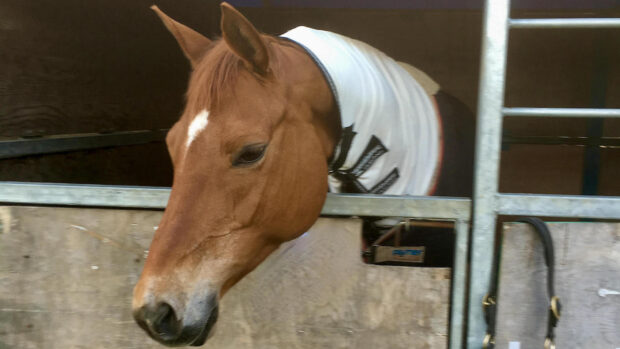Acupuncture involves inserting fine sterile stainless steel needles into specific sites on the body called acupuncture points. These are areas on the skin that overlie dense collections of tiny blood vessels and free nerve endings. The needles commonly used in horses vary from a few millimetres to 8cm in length. This is known as “dry needling”.
Other types of acupuncture include:
- Electroacupuncture — effective for chronic pain. The points are electrically stimulated by attaching leads from a battery operated electroacupuncture unit to the inserted needles
- Laser acupuncture — a low intensity laser is used on the points
- Moxibustion — cigar-like sticks of the herb Artemesia vulgaris are lit at one end and used to heat the needles or moved slowly in a circular fashion over the point to be treated. This is particularly good for chronic arthritic conditions in the cold winter months
- Aquapuncture — substances such as vitamin B12, local anaesthetic or homeopathic medicines may injected into a point
- Gold beads can be implanted to provide long-term stimulation of a point
- Trigger point acupuncture — the needles are inserted into trigger points, which are small circumscribed exquisitely tender knots that may be found within taut bands in a muscle. Trigger points are very common in horses and may form in response to a direct injury, chilling, chronic overuse of a muscle or repeated microtrauma (repetitive strain injury). Trigger points can lead to chronic pain and muscle shortening, causing the horse to change its action to a short, choppy gait. Affected animals are often grumpy and dislike being rugged and groomed.
What is acupuncture used for?
It can be used to treat almost any medical condition with the exception of malignant tumours, irreparable fractures and end-stage organ failure. It is often used with conventional veterinary treatment, so the horse experiences the benefit of their combined effects. It works well with complementary therapies, including physiotherapy, chiropractic, osteopathy, healing and homeopathy.
In equine practice, acupuncture is commonly used for:
- Muscle soreness, particularly of the neck, shoulders, back and hindquarters. Clinical signs that may be alleviated by acupuncture include “cold backs” — resentment of saddling and girthing, dipping on mounting; general stiffness or inability to bend on one or both reins; head tilt or inability to flex from the poll; shortness of stride and not going forward from the leg; disunited or bunny-hopping at canter; “hopping” on the transition from walk to trot; bucking on the transition from trot to canter; irritability and soreness during grooming.
- Arthritis
- Digestive problems, including poor appetite, diarrhoea, some types of colic
- Respiratory problems
- Reproductive problems
- Poor immunity and post-viral lethargy
Who can do acupuncture?
By law, acupuncture can only be performed by a vet. This is because it is an invasive procedure that requires a thorough knowledge of veterinary anatomy and physiology.
How does acupuncture work?
Inserting the acupuncture needles stimulates tiny nerve endings that carry impulses to the brain and spinal cord. This results in responses within the nervous and endocrine systems, leading to the release of neurotransmitters and hormones influencing the body tissues and organs. The effect of an individual needle depends on where it is placed in the body and which nerves are stimulated.
Acupuncture is particularly good for pain relief, as it increases the release of natural painkillers such as endorphins and enkephalins. These act on the pain pathways in the brain and spinal cord and can block the transmission of incoming pain signals.
An acupuncture needle has a direct effect on trigger points in tense, shortened muscles. As a needle penetrates a trigger point, the muscle will often contract and then lengthen almost immediately. Sometimes the needle is “grasped” by the muscle and relaxation takes place over 20-30min. This process can often be hastened by twirling the needle. As soon as the trigger point relaxes, the pain and tenderness disappear and the blood supply to the muscle improves.
Acupuncture also helps restore a patient to a state of balance, or homeostasis. By influencing part of the brain called the hypothalamus, acupuncture can affect homeostatic regulatory mechanisms such as the control of pulse, respiration, hormone secretion, intestinal motility and white blood cell production.
How do I find a veterinary acupuncturist?
A list of vets who perform acupuncture in each county can be found on the Association of British Veterinary Acupuncturists website: www.abva.co.uk



